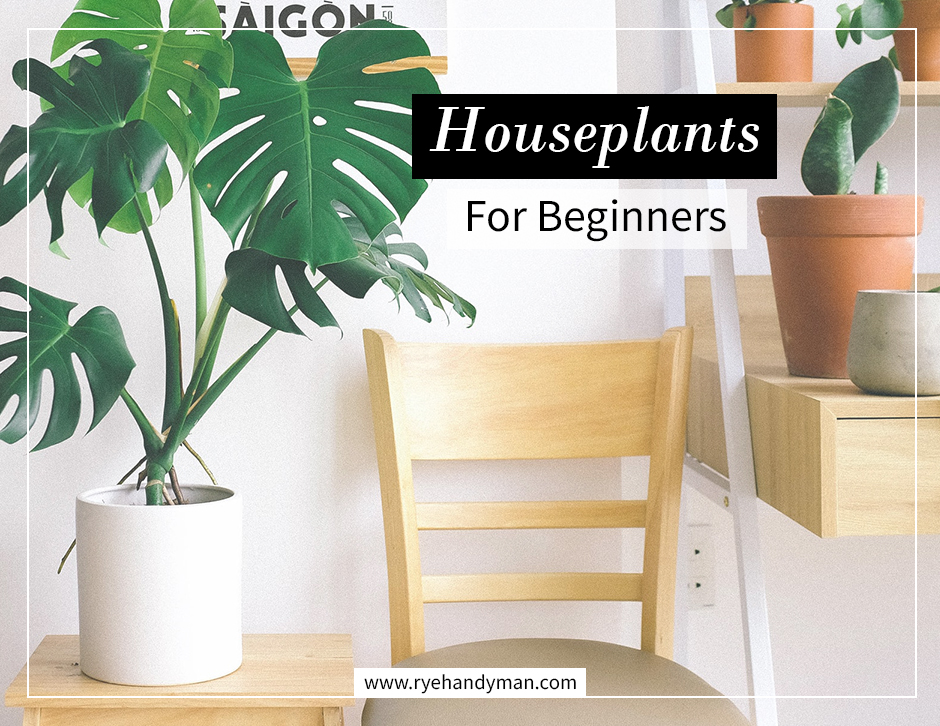
Houseplants for Beginners

There’s nothing like a little greenery in a house to bring nature indoors, and there are so many benefits to houseplants, including purifying air and reducing stress levels. Even the least green-fingered of people can find plants to suit them; the only downside being that plant collecting can become rather addictive. We’ve listed our favourite houseplants that are ideal for beginners and experienced gardeners alike, so why not treat yourself?

Spider Plant (chlorophytum comosum)
A classic low-maintenance house plant, the spider plant’s variegated leaves create a halo around the pot. With care, the plant can produce ‘flowers’ on long stems which can be propagated to create new plants.
Light: ideally bright but indirect light.
Care: keep the soil moist to the touch and water little and often (this may be less frequent during the winter months). Spider plants prefer normal room temperature but may suffer if exposed to extremes.
Toxicity: non-toxic to pets and children but may cause digestive issues if ingested.
Troubleshooting: if the plant starts to wilt, it may be that it’s had too much water so allow it to dry out a little more before watering again. It’s also an indication of too much or not enough sunlight, as spider plants require some sunlight but not too much and not direct.
Buy: £12.99; Beards & Daisies

Chinese Money Plant (pilea peperomioides)
The clue is in the name – the Chinese money plant comes from China! Cuttings were imported to Europe by a Norwegian missionary and it’s a plant commonly seen in Scandinavian interiors. The rounded leaves are reminiscent of lily pads and it is an easy, low maintenance plant suitable for all homes and offices.
Light: ideally suited to a warm bright position but not in direct sunlight.
Care: water weekly or so, ensuring the top layer of soil is dry to the touch before watering again. During the winter months water every fortnight, but mist regularly to keep the leaves moist. They are most comfortable in temperatures above10˚C.
Toxicity: non-toxic to pets and children, although ingestion may cause some discomfort, and possibly vomiting and diarrhoea in pets.
Troubleshooting: pale leaves indicate the plant isn’t getting enough light so move it to a bright position and rotate it often to ensure the light reaches all of it. Brown leaf spots are an indication of too much sun, or during the winter it could be exposed to a chilly draft.
Buy: from £13; Canopy Plants

Pothos (epipremnum)
These trailing plants originate from French Polynesia and can be found in different variations including Devil’s Ivy, Marble Queen and Jade Pothos. Their vines make them an excellent hanging choice – we’ve even seen them set on a side table and encouraged to grow over a doorway!
Light: anything from low light to bright, indirect sunlight.
Care: water fortnightly and allow soil to dry completely between watering. If the soil is still moist after two weeks in the winter, only water every three to four weeks. They are most comfortable in temperatures above10˚C.
Toxicity: keep away from children and pets.
Troubleshooting: yellowing leaves and brown stalks indicate you’re overwatering it, so let the soil dry out before you water again. Alternatively, dry, crispy leaf edges indicate underwatering and too much sunlight, so move it into the shade and allow it to soak for a short while.
Buy: from £21; Canopy Plants

Peace Lily (spathyphyllum wallisii)
Commonly known as a ‘Japanese peace lily’, they come from southeastern Asia and the tropical regions of the Americas.
Light: anything from low light to bright indirect sunlight. Peace lilies can cope with most temperatures above 10˚C.
Care: water weekly and fortnightly in the winter months.
Toxicity: although considered non-toxic, peace lilies contain compounds that can cause large amounts of irritation. If you have pets in particular that like to chew on a leaf or two, it’s best to keep them well out of the way.
Troubleshooting: drooping leaves are an indicator that your lily isn’t getting enough water, but will perk up soon after you’ve given it a soak. If you see brown or yellow leaves, it’s had too much light and needs to be moved into a shadier area.
Buy: from £10; Patch Plants

Aloe Vera
Originating from the Mediterranean and East Africa, aloe’s most well-known quality is the use of it’s inner gel-like substance to soothe burns. If you visit the Canary Islands you’ll see entire shops dedicated to aloe products including moisturisers and make up. Their structural leaves are perfect for minimalistic interiors and they’re sturdy and require only a little care so are ideal for beginners.
Light: bright, indirect sunlight is best as aloes in low light tend to grow ‘leggy’.
Care: water every three to four weeks, checking the soil to ensure it’s dry before watering again. In winter, water even less frequently. Aloes prefer warmer temperatures, so make sure they’re not in anything less than 13˚C.
Toxicity: while aloe vera can be found in many products for both pets and humans, the substance used has been through stringent tests. The original plant contains aloin which can cause all sorts of problems when ingested, so it’s best to keep the plant away from children and pets.
Troubleshooting: leaves turning pale or bending in the middle is a sign the aloe needs more light, so move it to a bright spot that doesn’t receive too much direct light. Rotating the plant will allow the light to reach all the leaves so it’s not leaning towards it. Brown and ‘mushy’ leaves are an indication of too much water, so allow the soil to dry out before watering again.
Buy: from £11; Forest London

Rubber Plant (ficus elastica)
If you’re looking for something fill in some floor space, the rubber plant is ideal. It comes from southeast Asia and Indonesia and the statement leaves are eye-catching.
Light: preferably medium, indirect sunlight to dappled direct light.
Care: weekly watering and misting to stop the leaves drying out. Allow the soil to dry out completely before watering again, which maybe fortnightly during winter months. Rubber plants thrive in temperatures between 16-24˚C but anything less than 12˚C and they’ll struggle.
Toxicity: keep away from children and pets.
Troubleshooting: if the leaves start falling, increase the humidity by popping the plant onto a pebble tray filled with water (just make sure the soil does not touch the water) or misting regularly. If the leaves start browning or drooping, it’s been overwatered so let it dry out completely before watering again.
Buy: from £19.50, House of Plants

Flamingo Flower (anthurium)
Anthuriums are native to the tropics of south America and are a favourite plant for modern interiors with their waxy, futuristic-looking flowers.
Light: bright but indirect light – so no sunny windowsills.
Care: water and mist weekly, making sure the top layer of soil is dry before watering again. In winter months reduce the watering to a fortnight or more. Anthuriums prefer warmer, humid temperatures thanks to their tropical roots so anything between 18-22˚C.
Toxicity: keep away from children and pets.
Troubleshooting: brown leaves and tips are a sign of too little or too much water – if the soil is dry, water it, and if it’s moist allow it to dry out some more before watering again. If the leaves are yellow it’s receiving too much sun, so it needs to be moved away to a less sunny spot. Green flowers are an indication of too little sun, so giving it some more light will ensure the new flowers come through coloured.
Buy: £26; Bunches

Snake Plant (sansevieria trifasciata)
The snake plant originates from southern and central Africa, and is one of the easiest plants to care for. It’s well-known for it’s air-purifying qualities so is ideal for the bedroom and office.
Light: all types, from darkened corners to direct sunlight.
Care: water every fortnight, allowing the soil to dry out completely between each watering to prevent root rot. During the colder months you can water as little as once a month – check to see how moist the soil is and only water if dry. Snake plants are fairly hardy and can cope with various temperatures but won’t thrive in anything less than 10˚C.
Toxicity: keep away from both children and pets.
Troubleshooting: if the leaves start to brown or yellow, the plant is overwatered or has little to no drainage. Wait for the soil to dry completely before watering and ensure the pot has sufficient drainage holes.
Buy: £18; Leaf Envy

Swiss Cheese Plant (monstera deliciosa)
A favourite of interiors designers all over social media, the large structural leaves of the monstera deliciosa make it a true statement plant. It suits both floor space and a side table or work surface, and like it’s smaller cousin below, comes from southern Mexico and Panama.
Light: anything from low light to bright but indirect sunlight.
Care: weekly watering and misting regularly, although it can be as little as once every fortnight during winter months. Allow the soil to dry completely before watering again. The humidity found in bathrooms is ideal or group it with other plants to increase the humidity in the surrounding air – and it won’t thrive in anything less than 10˚C.
Toxicity: keep away from children and pets
Troubleshooting: yellow leaves are an indication of too much light or overwatering, so move the plant into the shade and let the soil dry out before watering again. Alternatively, brown leaves indicate it may not be getting enough light or moisture, so give it a little more sun and mist regularly.
Buy: £38; Leaf Envy

Monkey Mask Plant (monstera adansonii)
These little plants are smaller cousins to the popular monstera deliciosa. They come from the tropical climates of southern Mexico and Panama, and grow from the rainforest floor up the trees in vines. They’re perfect if you love the unusual shape of monstera but haven’t necessarily got the room for the deliciosa.
Light: ideally, bright but indirect sunlight. Growth is slower in low light, and direct sunlight can burn the leaves.
Care: water weekly and allow the soil to dry out in between – this can be decreased to once a fortnight or so in the winter. The humidity found in bathrooms is ideal but otherwise mist the leaves occasionally – and it won’t thrive in anything less than 10˚C.
Toxicity: keep away from both children and pets.
Troubleshooting: if the leaves start turning yellow they may have had too much light or overwatering. Move the plant out of direct sunlight or into a slightly shadier area and ensure the soil is dry before watering again. Alternatively, brown leaves are a sign the plant isn’t getting enough light or there’s not enough moisture.
Buy: £16; Bloomboxclub
Even those new to owning house plants will find these difficult to kill, and having greenery around is proven to improve mood and concentration as well as brightening up the place and ridding the air of toxins. Let us know your favourite houseplants in the comments below!



